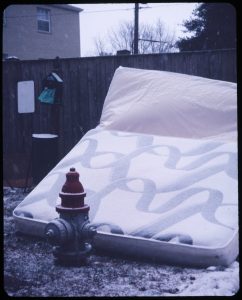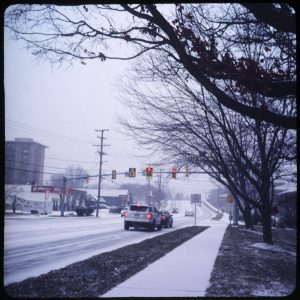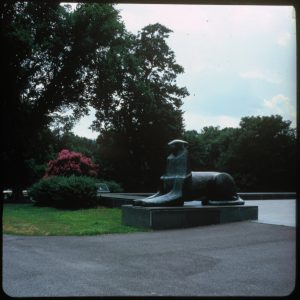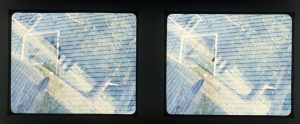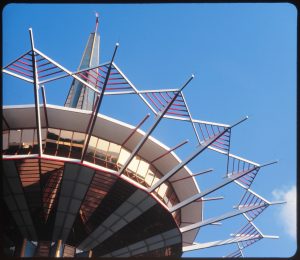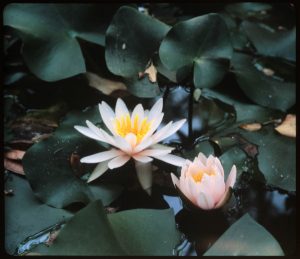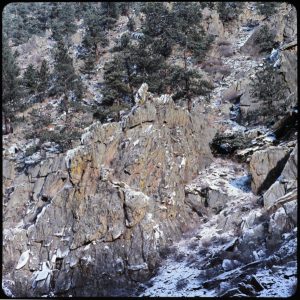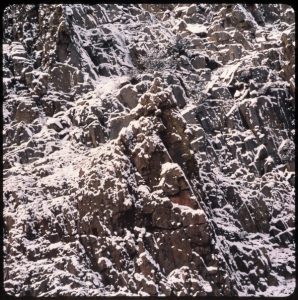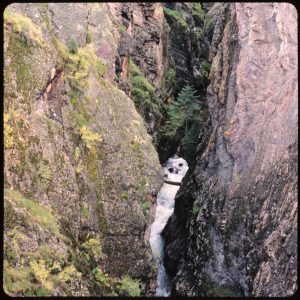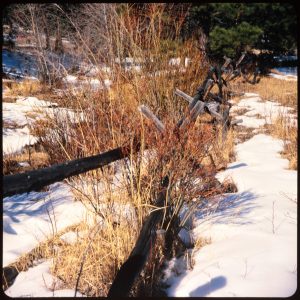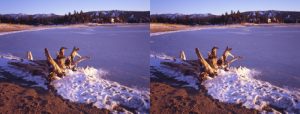
For ‘Ski Week’ over President’s Day I took my family up to Big Bear Lake for some local skiing. We were lucky to catch a storm and some fresh snow. The weather was cold in the teens and this side of the lake froze over. I got in some running before sunset and took my Fuji GA645w with me. This cha-cha has some nice light and no water movement, so it worked out well. This was also my last roll of Fuji Provia 400x, a favorite film stock of mine. When I got home I looked on eBay and was shocked to see the sky high prices. Those 2D shooters don’t deserve this film; it should be reserved for us 3D people. My 2 cents.
Friends And Other Inanimate Objects, Volume One
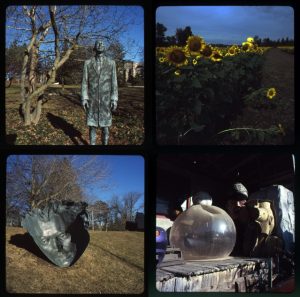
Counterclockwise, from upper left:
“For Fear Of Branching Out on Arbor Day” – expired Provia 100F.
“Goin’ Pseudo” – expired Provia 100F.
“Behold! The Omnipotent, Ever-Knowing VooDoo Orb Sac!” – expired Astia 100F.
“Weather Most Fowl” – egg-spired Astia 100F, using the Sunflower 16 rule.
All images captured with a TL120-55, and home-processed using a JOBO CPP2 unit, with Unicolor or Arista E6 chemistry.
Kat in Studio
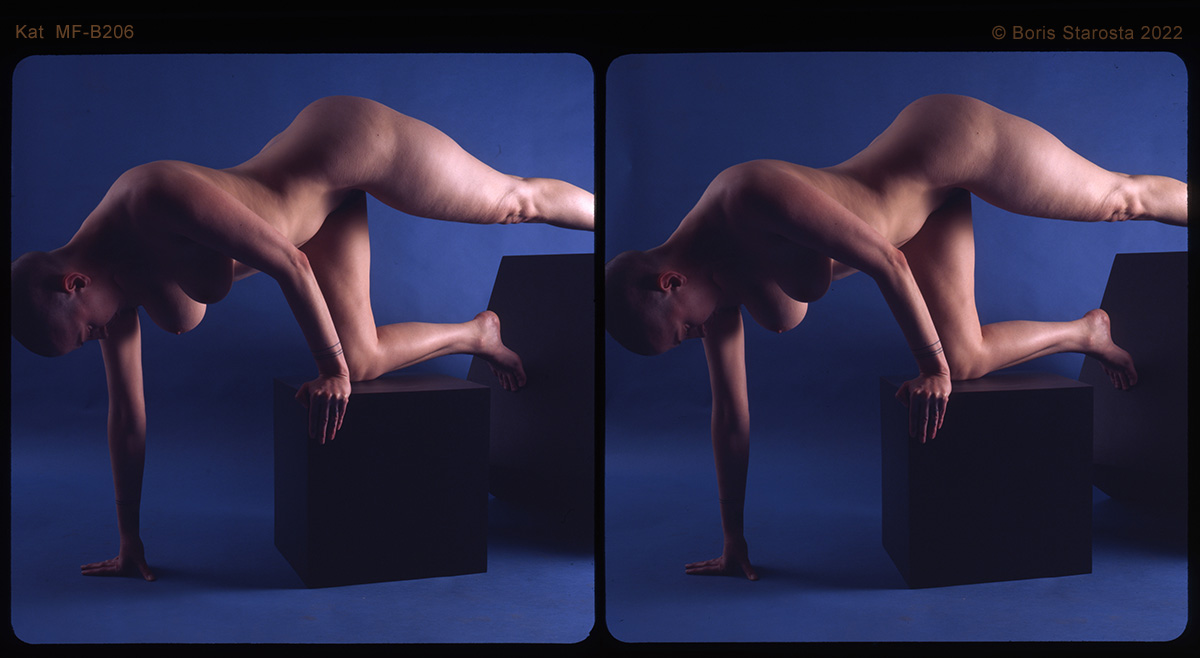 Kat MF-B206.
Kat MF-B206.
I try to make sure my models don’t grow bored in the studio. Exercise helps. Shot with the twin Mamiya 6 Rig, studio strobes, on Kodak E100G film.
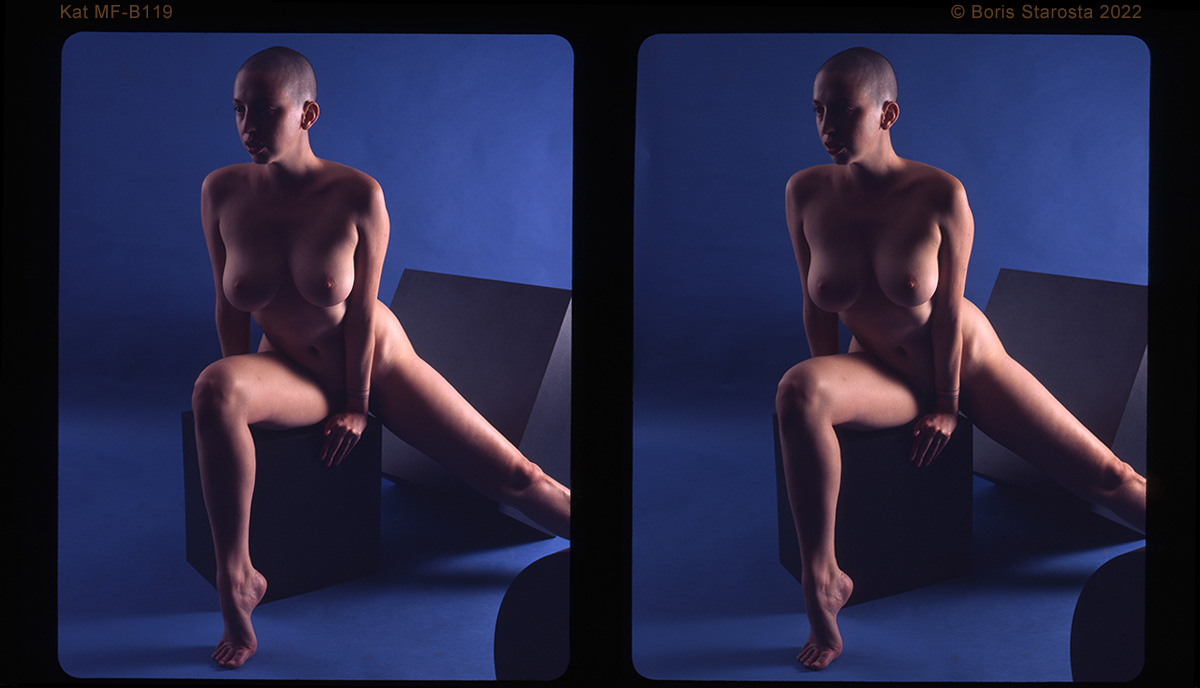 Kat MF-B119.
Kat MF-B119.
Two views from the “No Spectators” show at the Renwick Gallery
In 2018 we traveled to visit the Renwick Gallery in Washington, D.C. Descriptions below in part taken from online sources:
No Spectators: The Art of Burning Man brought the large-scale, participatory work from this desert gathering to the nation’s capital for the first time. The exhibition took over the entire Renwick Gallery building and surrounding Golden Triangle neighborhood, bringing alive the maker culture and creative spirit of this cultural movement.
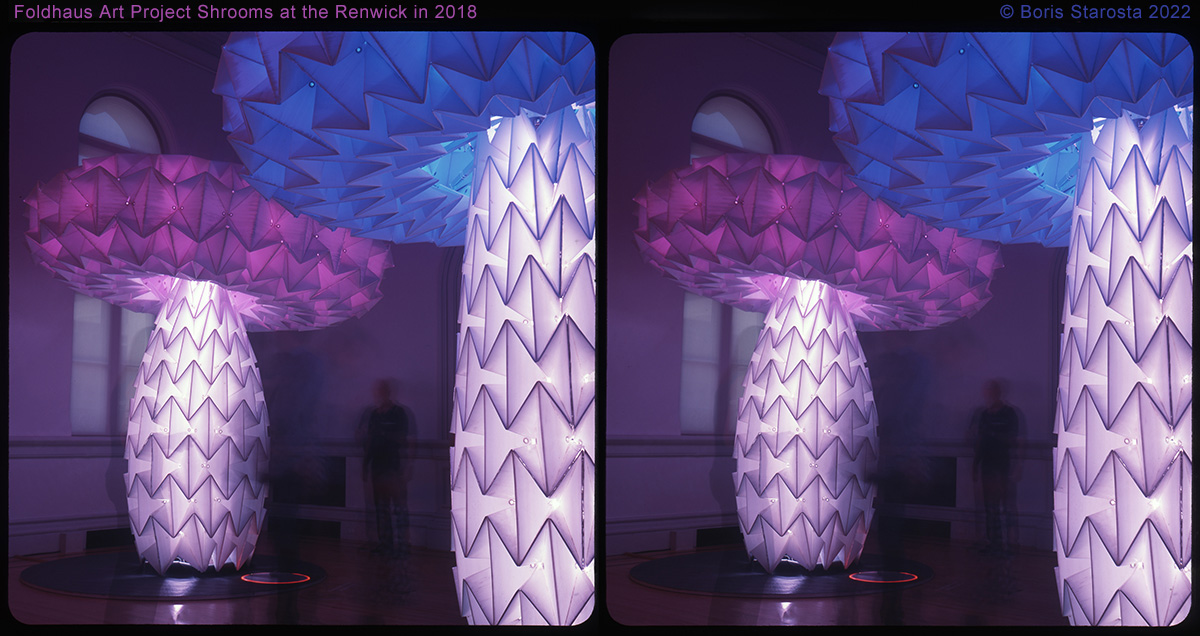
FoldHaus Art Collective’s Shrumen Lumen: The elements of this sophisticated, interactive cluster of fungi each has its own particular character responding to human interaction. As participants step on the footpads located beneath each cap, the mushrooms gently grow and “breathe.zzzzz’ In daylight the grouping appears ethereal white, while at night, it magically transforms with embedded LEDs that glow through the translucent outer skin to bring the installation to life.
 Truth is Beauty by Marco Cochrane. Cochrane first sculpts his pieces by hand before constructing them from steel triangles at grand proportions. Built using a mold of the original clay sculpture, the version of Truth Is Beauty in the gallery is one-third the size of the fifty-five-foot tall figure that appeared at Burning Man in 2013.
Truth is Beauty by Marco Cochrane. Cochrane first sculpts his pieces by hand before constructing them from steel triangles at grand proportions. Built using a mold of the original clay sculpture, the version of Truth Is Beauty in the gallery is one-third the size of the fifty-five-foot tall figure that appeared at Burning Man in 2013.
Both images acquired with my Sputnik, about 30s exposure f22 I guess, on 100ASA Fuji RDPIII film.
Jim Roy’s D23 submission
Note: I’ve had some issues getting Jim signed up on the site, so I’m posting this description he sent to me. -Ian Andvaag
Newly included slides are mostly taken with a Sputnik acquired from Paul Gillis, but badly metered on a dark snowy day. They are “Bit of Snow” taken at our first snowstorm, “Ultimate Rest”, taken at our nearest apartment trash fort and hydrant, “A Little Snow” on Woodrow Wilson Boulevard just outside our apartments, and “Netherlands Memorial Lions”, taken at Marine Memorial Park’s Netherlands Carillon (recently restored) with a hand held Rolleiflex in the 1990s. I wish I still had that camera, since I reduced my camera pile from 88 in 2004 to “only” 28 today. The only 120 film ones left are a 1960 vintage Sputnik, 1930 giveaway cardboard Kodak 50th Anniversary, and a 1926 Rolleidoscop which needs repair.
Jim Roy
Nik Sekhar A32 Submission
[This post was created by Ian Andvaag on August 2, 2023 to create a place for people to leave comments on Nik Sekhar’s slides. It has been dated to February 4, 2022 which is when Nik had the folio.]
[Flowers Close-Up]
[Front Yard]
[Nik’s Son Holding Cat]
[Star Wars Birthday Cake]
Paul Gillis’ slides for d23
Well, it’s been about 9 months since I last had the dragon box in my grubby little hands. I wish I’d taken more MF3D images in that time, but I guess it’s good that I at least got a few. All four of these were taken with my TL-120 on Provia 100F, using a tripod.
Conundrum Between Trees
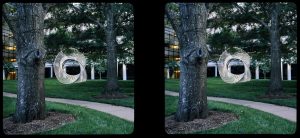
This is the same sculpture that I included in my previous entry (here). I took it on a later visit, and from much further back, so that it is framed by two sturdy trees. I think I like this shot better.
Here, Have Some Snips
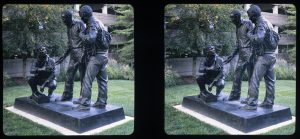
This sculpture is just a stone’s throw from the one above; but in an artistic sense they could hardly be farther apart. I still don’t know the name of either work, nor of the sculptors. I shot this very late in the day. The low light level was no problem, shooting from a tripod (2 sec. at f/11, I think) but it did result in some lights in the background coming out distractingly bright.
Dark Star Park (Arlington, Virginia)
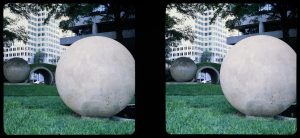
Finally, some sculpture that I know something about! This little park (larger than what I show here) is actually very close to the US Marine Corps War Memorial (the Iwo Jima sculpture). Another case of the abstract adjacent to the extremely realistic.
This park & all its sculptural elements were designed by Nancy Holt & built in 1984, commissioned by Arlington County. The Wikipedia article about her goes into some depth about it. I definitely want to go back & photograph the park from other angles. The biggest challenge I had was that from most viewpoints the background was in full sun, while the sculptures were in shade.
Broken Outflow Pipe
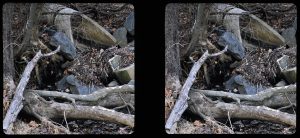
Maybe another inadvertent kind of sculpture? Obviously not a very colorful subject, but I was drawn to the 3-dimensional complexity. Another long exposure as the day was waning.
Colony Place

Colony Place
This is along the main tourist shopping street just outside the cruise ship center in Nassau, Bahamas.
This was taken with a handheld (string monopod) Sputnik on Fujifilm Provia 100F.
Red Window
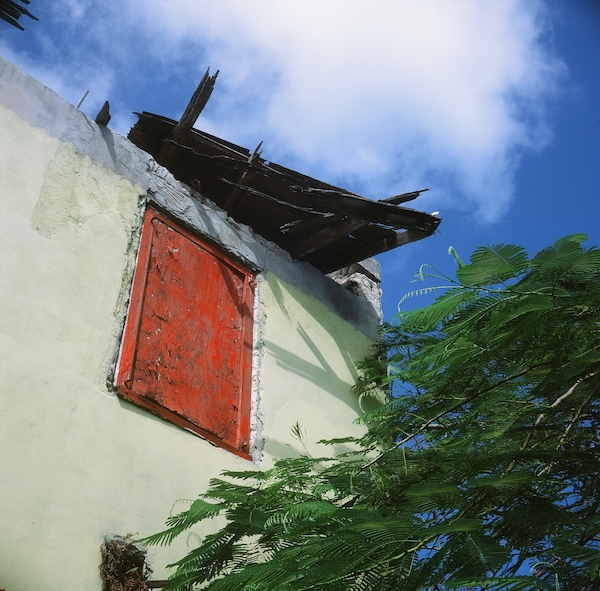
Red Window
Not being one for shopping I wandered off the main throughfare to see what might be more interesting. Luckily we had spectacular weather, which lead to some very nice color contrasts.
This was taken with a handheld (string monopod) Sputnik on Fujifilm Provia 100F.
Unlike most of my mounted slides, I accidently labeled this one on the front side as seen from a viewer.
Green Porch
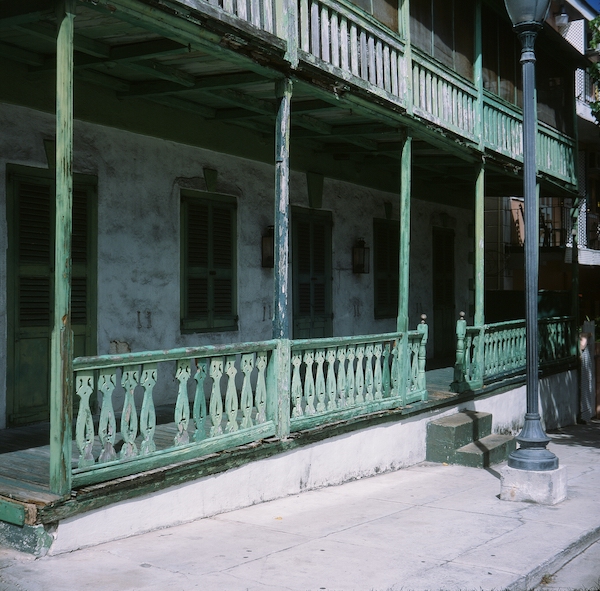
Green Porch
Just past the Red Window was this porch. I’m not sure what the building was, but the texture and coloring attracted me to it.
This was taken with a handheld (string monopod) Sputnik on Fujifilm Provia 100F.
Columbus
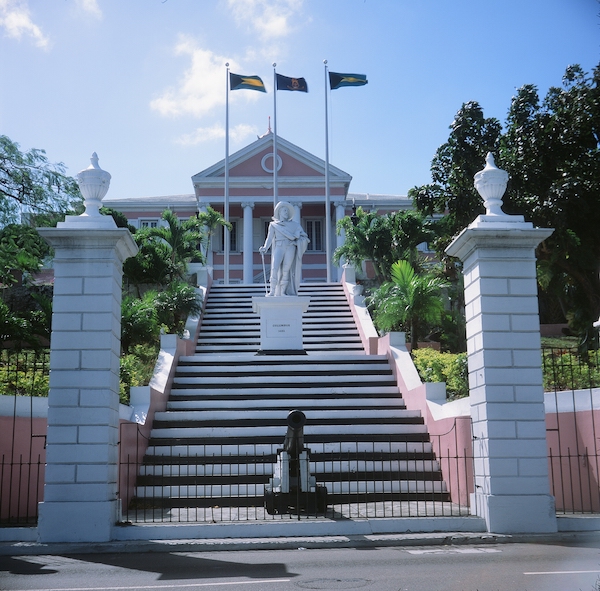
Columbus
Back behind the tourist shopping area is a collection of government buildings. This statue of Columbus is protected by a fence and cannon. I didn’t see any placard describing the building.
This was taken with a handheld (string monopod) Sputnik on Fujifilm Provia 100F.
Ray Dillard – Some old, some new, some that didn’t work so well
I continue to experiment with multiple exposures. I had some failed attempts at indoor shots; somewhere my math went horribly wrong! I will continue to work on the math and measurements and make more attempts at indoor multiple exposures.
This first image I have included, titled “Angles”, is a look at shooting not only multiple exposures, but a variety of camera angles. I was interested to try and create a combination of vertical and horizontal lines among obviously diagonally skewed lines. I was also interested in the skewed lines being confused further by clearly being objects that should NOT be skewed. I plan to do more experimenting with this angular approach to multiple exposures. This is from a recent set of experiments. Five exposures on my Sputnik, handheld, with Fuji Velvia 100.
“Angles”
The next image is titled “Global Focus 3”. This variation of an image posted in a previous pass of the folio utilizes a slightly different alignment of the multiple shots. This variation is presented as it solves some of the issues commented on about the original version, while having other issues that worked better in the earlier version Global Focus presented a few years back. Thus is the nature of experimentation! I am a musician who has found experimentation to be a primary element of my 40+ year career of music making. This is just an extension of that reality. Two exposures on my Sputnik with Fuji Velvia 100.
“Global Focus 3”
Metal sculpture by Canadian sculptor Roy Hickling.
The third image I have included is “The Incursion”. This is also an earlier shot where I attempted to carefully place an object in a specific part of another object using a quadruple exposure. It is close to what I had hoped for, but size, perspective, alignment and exposure is a massive set of variables to deal with! Same sort of challenges as found in “Angles” above. Three exposures on my Sputnik with Fuji Velvia 100.
“The Incursion”
Metal sculpture by Canadian sculptor Roy Hickling.
Thanks to Steve Lederman for scanning these images for me!
Steve also developed some of the film for me in his home-basement-lab and used his superior skills to aid in some of the mounting.
Stereoscopic Creatures And Beasts, Or Where To Find Them

“BAR BAND“
Another pinhole picture, to the delight of some, and much to the chagrin of others. This is the mighty Heavyweights Brass Band entertaining a throng at Toronto’s Rail Path, an activity that started with the COVID 19 lockdown. The band decided to rehearse outdoors; a crowd soon gathered and threw money at them, so they made their Rail Path get-together into a weekly ritual. Seen here are Tom Richards, sousaphone, Lowell Whitty, drums, and Paul Metcalfe, tenor saxophone. Not pictured; John Pittman, trumpet, and RJ Satchithananthan, trombone. The image was a bit difficult to mount with the 3D World mounts – the step at the bottom left juts out on the left image more so than on the right image. I did try to use a cardboard close-up mount, but then a good portion of the image was lost. Just don’t glance down at the bottom left hand corner and you’ll be fine.
Captured with Clint O’Connor’s Limited Edition Stereo Flyer (#11 out of 100), on a Gorillapod, 2 second exposure, expired Fuji Provia 100F. Processed in my JOBO unit.
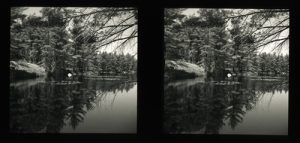
“MONOCHROME LAKE“
This was shot in a remote region of Northern Ontario, situated on Monochrome Lake, not to be confused with Black Lake, Mono Lake, Grey Lake or Gray Lake. The dumping of nuclear waste in the region caused the vegetation to devoid itself of its photosynthetic pigments, chlorophylls a & b, resulting in its inability to preferentially absorb light. This manifests as foliage with a very grey appearance. Monochrome Lake has experienced its fifteen minutes of fame – it was used as the location for the incredibly popular “Creature From The Black And White Lagoon” 3D movie franchise. It has also been featured in some episodes of the television series “Black And White Mirror”, currently streaming on one or another of those television streaming services that streams television. I guess that’s technically more than fifteen minutes of fame, as those “Creature” movies are well over an hour each. But I digress. Just in case you think I’m trying to hand you another one of my tall tales, I shot this image on Velvia 100 to prove that the area really looks like this in person. There. I knew that would convince you.
Captured with a Sputnik, handheld, on Velvia 100. Processed in my JOBO CPP2 unit.
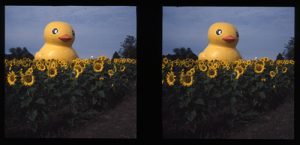
“BEWARE OF DUCK“
I wanted to obtain some sunflowers, as one is wont to do, and was shadowed by a highly-trained, very aggressive Attack Duck. It was a situation most fowl! I was operating on a wing and a prayer as it tried to egg me on! When I finished gathering the sunflowers I told it to send me the bill!
Captured with a 3D World TL120-1 modified with a Thurston lens board and Mamiya 55mm lenses (TL120-55) on EGGspired KoDUCK E100G, sunny 16 (Sunflower 16) rule, processed in my Jobo CPP2 unit.

“SCREAMING HEADS TWO“
A wide angle cha-cha experiment. The lower left hand corner has an issue, so don’t glance down there. I’m sensing a theme! I shot this handheld, so perhaps it’s time to invest in a slider bar. From my similar submission to the recent Dragon Folio loop:
“Every year, Worldwide Pinhole Photography Day falls on the last Sunday in April. It is an excuse for my daughter and I to spend a day together photographing various locations in Ontario using pinhole cameras. I will usually pack a “lensed” camera in addition to my pinhole camera(s). On WPPD 2019 we visited artist Peter Camani’s residence which hosts his grand scale outdoor art exhibition. There are various shapes of cast concrete screaming heads situated throughout his 310-acre property near Burk’s Falls, Ontario, each sculpture being in the 15-20 foot tall range. On this occasion I had packed my Hasselblad SWC, and I can’t remember if I was consciously trying to capture a stereo cha-cha image or not. In any case, I found an uncut roll of film with three pairs of images that looked like they might work as stereo pairs. Despite some anomalies between the left and right chips, my brain can fuse these images into a stereo image. Hasselblad SWC, yellow or orange drop-in filter, expired Kodak Aerochrome film, home processed with a Jobo CPP2 unit.”

